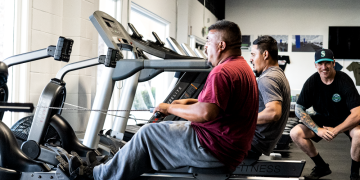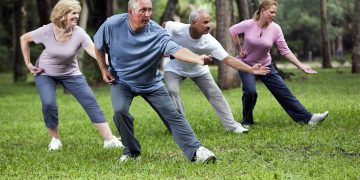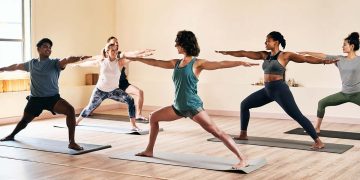When we think of longevity, the focus often drifts toward diet, genetics, or stress management. But your daily workout—yes, the very one you may take for granted—is a silent architect shaping how well and how long you live. The good news? You don’t need to overhaul your entire training regimen to gain benefits. Small, science-backed tweaks can make a monumental impact on how your body performs, recovers, and thrives with age. From subtle shifts in breathing to smarter warm-ups, these minor modifications will not only boost your fitness but will also add resilience and vitality to your later years.
1. Embrace Nasal Breathing During Cardio
Breathing through your nose during moderate-intensity workouts may feel awkward at first, but the science supports its benefits. Nasal breathing filters and humidifies air, reduces blood pressure, and improves CO2 tolerance—a key factor in oxygen delivery. Studies show that it can also increase endurance and decrease perceived exertion over time. This technique forces you to slow down and stay within an aerobic zone, which is where longevity magic happens. It reduces systemic inflammation and helps build a more efficient cardiovascular base.
2. Focus on Joint Mobility Over Static Stretching
Traditional pre-workout static stretching may not be the golden standard anymore. Instead, joint-focused dynamic mobility routines—like controlled articular rotations (CARs) and animal flow movements—offer more longevity benefits. They maintain joint capsule health, improve range of motion, and reduce injury risk. Especially as we age, it’s not just the muscle fibers that need attention, but the connective tissues and joint integrity that keep us moving fluidly. Daily mobility work improves proprioception, essential for balance and fall prevention.
3. Prioritize Eccentric Strengthening
Most people focus on lifting weight up (the concentric phase), but the real longevity benefit lies in lowering it down slowly—the eccentric phase. Eccentric training builds greater muscle control, strengthens tendons, and reduces the risk of injury. Studies have shown it to be especially effective in combating sarcopenia, the age-related decline of muscle mass. For example, taking 3–5 seconds to lower yourself during a squat or push-up challenges your muscles in a way that translates to improved resilience and better long-term performance.
4. Incorporate Single-Leg Movements
Adding unilateral exercises like Bulgarian split squats, single-leg deadlifts, and step-ups enhances balance, corrects muscular imbalances, and strengthens stabilizer muscles. These are the muscles that often protect us from falls and injuries in everyday life. According to research from the Journal of Aging and Physical Activity, single-leg strength correlates closely with fall prevention in older adults. It also boosts core activation and ankle stability, two underrated factors in whole-body health.
5. Shorten Workouts, But Increase Frequency
More doesn’t always mean better. Research suggests that 30-minute moderate-intensity sessions five times a week can be more beneficial for longevity than infrequent, long-duration sessions. This tweak encourages consistent movement and avoids burnout. Daily movement, even in shorter doses, stimulates metabolic flexibility, joint lubrication, and improved circulation—all vital for maintaining energy and organ health as you age.
6. Add Isometric Holds for Stability and Endurance
Isometric holds—such as planks, wall sits, or paused squats—build strength and muscular endurance without repetitive joint impact. They’re excellent for injury rehab and for maintaining tension across muscle groups, promoting better neuromuscular coordination. Isometric training can also reduce blood pressure and increase tendon stiffness in a positive way, particularly around the knees and shoulders. Even just 30 seconds of static holds at the end of your set can have lasting strength and structural benefits.

7. Train in Multiple Planes of Motion
Too many workouts exist in the sagittal plane—forward and backward motion only. Life, however, happens in three dimensions. Incorporating lateral (frontal plane) and rotational (transverse plane) movements—like lateral lunges, wood chops, or rotational med ball throws—develops a more complete, agile, and resilient body. Training across all planes improves coordination, helps prevent overuse injuries, and promotes joint health. It also better prepares you for real-world challenges, from picking up grandkids to avoiding a fall on uneven pavement.
8. Use Tempo Training to Tune Your Nervous System
Slowing down your reps with controlled tempo (e.g., 3 seconds down, 1 second pause, 1 second up) builds time under tension, improves mind-muscle connection, and enhances muscular endurance. This technique trains your nervous system to become more efficient at recruiting muscle fibers and reducing compensatory patterns. Over time, this leads to stronger neuromuscular health—one of the key predictors of physical longevity. Tempo training is particularly effective when combined with moderate weight and good form.
9. Start Every Workout with Breathwork and Grounding
Before you grab a dumbbell or hop on the treadmill, start with 3–5 minutes of diaphragmatic breathing. Lie on your back with knees bent, one hand on your chest, the other on your belly. Breathe in through your nose, expanding your belly, and exhale slowly. This primes your parasympathetic nervous system, reduces cortisol, and sharpens focus. Pair it with grounding—standing barefoot or on a grounding mat—to reduce inflammation and improve autonomic regulation. It sets a calm, intentional tone and prepares your body to respond—not react—during training.
10. Periodize Your Training Based on Recovery, Not Ego
Longevity fitness is not about pushing hard every day—it’s about knowing when to push and when to pause. Instead of arbitrarily programming “leg day” every Tuesday, start planning workouts based on sleep quality, stress levels, and recovery biomarkers (like heart rate variability, or HRV, if you track it). This approach personalizes your fitness, honors your body’s changing needs, and protects against overtraining. True strength isn’t just lifting heavier—it’s knowing when to rest, recalibrate, and come back stronger.
Conclusion: Longevity Is in the Details
The fountain of youth might not lie in a secret supplement or extreme workout regimen, but in the little things you do consistently. These ten tweaks are not about training harder—they’re about training smarter. Each one serves as a thread in the tapestry of a long, healthy, mobile life. By breathing better, moving with intention, and listening to your body’s cues, you don’t just add years to your life—you add life to your years. So the next time you hit the gym, lace up your shoes with purpose. With every thoughtful rep and every mindful breath, you’re not just working out. You’re investing in your future.

















































